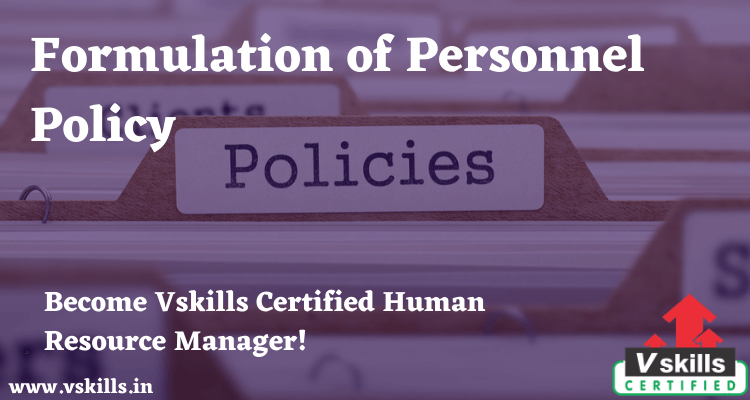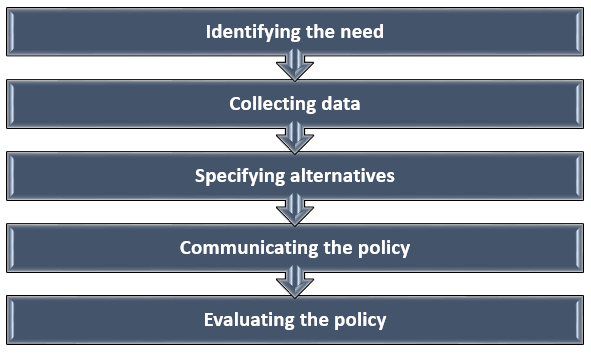Formulation of HR Personnel Policy – Policy formulation and implementation involve the following steps:
1. Identifying the need: Initially, important areas of personnel management in HR (recruitment, selection, training compensating bargaining) must have a policy formulation that is clearly spelt out. Additional policy guidelines can come at any stage depending on the recurrence of the ticklish issues at various levels.
2. Collecting data: Once priority areas are listed, steps should be taken to collect facts before formulating a policy. Various sources could be tapped for these purposes such as (1) company’s records (2) past practices (3) survey of industry practices (4) experience of personnel handling various issues (5) top management philosophy (6) organizational culture (7) employee aspirations and (8) changing economic, social an legislative environment, etc.
3. Specifying alternatives: Policy alternatives should emerge clearly after collecting relevant data from various sources. These have to be evaluated carefully in terms of their contribution to organizational objectives. It is always better to involve people at various levels, especially those who are going to use and live with such policies. Top management should put the stamp of approval only when everything is above board and the stated policy clearly reflects organizational priorities.
4. Communicating the policy: In order to gain approval at various levels, the formulated policy should be communicated throughout the organization. Policy manuals, in-house journals, and discussions with people at various levels may be used to reach out to employees quickly.
5. Evaluating the policy: Personnel policies, to be effective must be reviewed evaluated and controlled regularly against certain established standards. Evaluation helps determine changes in existing policies. All these policies should be reviewed annually and some policies should be reviewed at specific times for example when there is collective bargaining or after strike / lock out etc. Departmental policies may be reviewed through the participation of all employees. Outside consultants or experts from other organizations may be engaged to review crucial policies. Adequate care should be taken to review the policies in the following situations when (1) employees offer suggestions ; (2) employees express grievances (3) unsatisfactory reports about employees performance and behavior (4) company plans for change like expansion, diversification, contraction, adoption of new technology and introduction of new methods. Personnel policies, to be effective should have a favorable impact on the objectives and functions of P /HRM and help the parties concerned.
Need for Formulation of Personnel Policy
Formulating a personnel policy is necessary for several reasons. These include:
- Setting clear expectations: A personnel policy establishes clear guidelines and expectations for employee behavior, conduct, and performance. This helps to ensure consistency in the workplace and provides a framework for addressing issues and concerns.
- Compliance with laws and regulations: A personnel policy ensures that the organization complies with relevant employment laws and regulations, such as those related to discrimination, equal employment opportunity, and workplace safety.
- Attracting and retaining employees: An organization that has a well-formulated personnel policy can attract and retain employees by providing a clear and fair framework for compensation, benefits, and performance management.
- Promoting a positive work environment: A personnel policy can promote a positive work environment by setting expectations for respectful behavior, addressing harassment and discrimination, and promoting work-life balance.
- Enhancing organizational performance: A personnel policy that is aligned with organizational goals and values can enhance organizational performance by promoting employee engagement, productivity, and commitment to the organization.
Overall, the formulation of a personnel policy is essential for creating a positive and productive work environment, ensuring compliance with legal requirements, and promoting organizational performance. It provides a framework for managing human resources effectively and efficiently.
Practice Questions
Q1. What is the first step in formulating an HR personnel policy?
A) Define the scope and purpose
B) Identify legal requirements
C) Gather input from key stakeholders
D) Develop policy content
Correct Answer: A) Define the scope and purpose
Q2. What is the purpose of gathering input from key stakeholders in formulating an HR personnel policy?
A) To ensure compliance with legal requirements
B) To identify potential issues or concerns
C) To set clear expectations for employee behavior
D) To communicate the policy effectively to all employees
Correct Answer: B) To identify potential issues or concerns
Q3. What are some key areas that should be covered in an HR personnel policy?
A) Recruitment, selection, and performance management
B) Workplace safety and employee conduct
C) Compensation and benefits
D) All of the above
Correct Answer: D) All of the above
Q4. Why is it important to communicate the HR personnel policy effectively to all employees?
A) To ensure compliance with legal requirements
B) To set clear expectations for employee behavior
C) To attract and retain employees
D) To enhance organizational performance
Correct Answer: B) To set clear expectations for employee behavior
Q5. What is the purpose of reviewing and updating the HR personnel policy regularly?
A) To ensure compliance with legal requirements
B) To address changes in the organization or legal requirements
C) To promote a positive work environment
D) To enhance organizational performance
Correct Answer: B) To address changes in the organization or legal requirements




